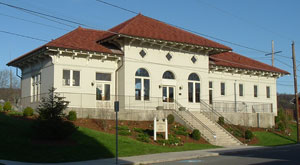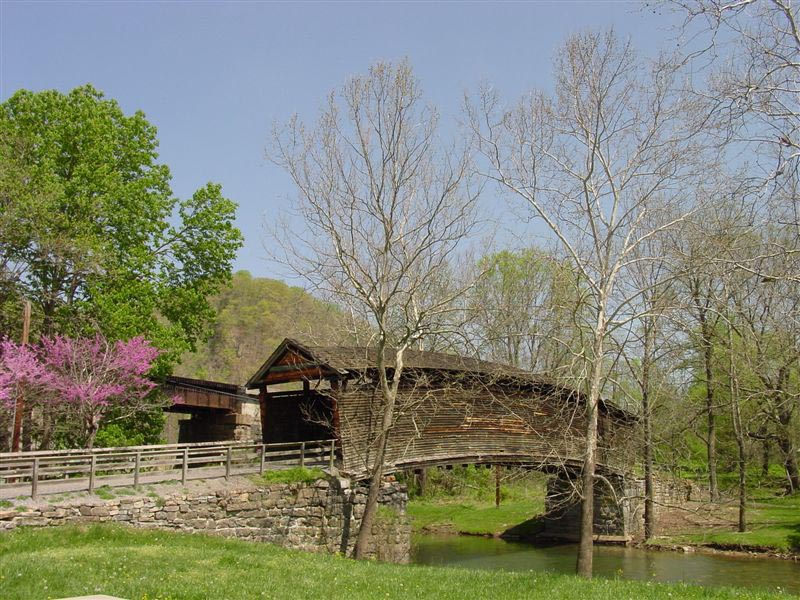C&O Depot
The train passenger service to Covington ended in 1971, both the passenger depot and former Railway Express agency building sat idle by the tracks. However, in 1995, the City of Covington made its first attempt to save the 1908 depot by applying for a grant from the Intermodal Surface Transportation Efficiency Act (ISTEA) of 1991. The initial application for a $700,000 grant was not successful but there was planning to make a second request. However on January 17, 1996, the Covington City Council voted to table action on the application, likely influenced by a blizzard and local flooding. Interest in the restoration of the passenger depot was rekindled by the Alleghany Historical Society. A number of groups, businesses and community leaders began to discuss the possibility of the restoration. Promises were made to raise the necessary matching funds and relieve the City of the financial burden, so Council voted on January 12, 1999 to submit the grant application. The restoration of the depot was a long and slow process but on October 8, 2003 a contract was awarded to Acorn Construction company to complete the renovation. In the Spring of 2004, construction began and the immediate work was to restore the unique terra cotta roof. The entire roof was removed and necessary structural repairs were made. Approximately 2/3 of the original tiles were salvaged and fortunately, the original manufacturer of the tiles was still in business and replacement tiles were obtained. Work continued and by 2006, the funding and work for the project had ended. While one could see the dramatic results of the depot from the outside, the interior was still in a rough condition. The electrical and plumbing work had been completed. The heating, ventilation and air conditioning system was operable. However, the main lobby of the building designed as a museum gallery was unfinished as well as offices for the Alleghany Historical Society. At this point, the City Public Works Department stepped forward and proposed to complete the interior for use though reduced in scope from what was called for in the original architectural plan. City Manager Claire Collins and the Covington City Council approved the plan with concurrence from the Historical Society. By the spring of 2007, the project was completed and the work of the City crews was exceptional. The depot is now a gathering place for Highlands citizens, a link to our past. For a schedule of events and information about reserving the restored C&O Depot for your special meeting or event, access the C&O Depot Operating Policy. For more information on events, call the Parks & Recreation office (540) 965-6360. The Depot is open on: Monday, Tuesday, Thursday and Friday from 1:00 p.m.-5:00 p.m. To contact the Alleghany Historical Society at the Depot dial (540) 965-0149.
Falling Spring Overlook - Falling Spring Overlook was recently donated to the Commonwealth of Virginia by MeadWestvaco. The dedication ceremony was held in late November, 2004. The scenic waterfall is located on Route 220 in Alleghany County, just five miles north of Covington, Virginia. The property has had extensive renovations to the overlook and grounds so that visitors can more safely stop and enjoy the view, making it one of the most visited spots in the Alleghany Highlands. The water from the falls flows into the Jackson River at the popular gathering spot of Camp Kyle on land owned by the R. W. Kyle family in the beautiful Falling Spring Valley.
Humpback Bridge - Three miles west of Covington, adjacent to U S Route 60 is Humpback Bridge Wayside Park. Built for the old James River and Kanawha Turnpike Company, it served many a traveler until 1929, when it was abandoned for traffic with the completion of the Midland Trail. The bridge was restored by the State Highway Department in 1954 which matched a $5,000 fund raised locally by the Covington Business and Professional women's Club. The wayside park was established at the same time. The five-acre area was cleared, picnic tables, fireplaces, restrooms and drinking fountain provided. The grounds were landscaped, but allowed to keep the natural, rustic appearance and over a hundred specimens of trees and shrubs native to the area have been tagged. Humpback Bridge, unique in bridge designs in the United States, has its original hand-hewn timbers which are put together with hand-made locust pins. The span is 120 feet long, with abutments placed 100 feet apart, with no middle support. The center of the floor and roof is about four feet higher than at the ends, thus giving the humped appearance from whence it was named. It is the only bridge of its design in the United States.
Humpback Covered Bridge Chronology (as recorded at the National Register for Historic Places):
1784, George Washington tours the Alleghany region and reports to the Virginia Assembly the necessity of constructing a system of canals and turnpikes to open trade and communication with the west.
1785 – James River Company incorporated
1816 – Virginia Board of Public Works established
1820 – Virginia General Assembly passes an act making the James River Company a state-operated venture and authorizes construction of a 208-mile road from the mouth of Dunlap Creek to the great falls of the Kanawha River
1824 – Three bridges were constructed on Dunlap Creek west of Covington, VA
1837 – Flood destroys all three bridges on Dunlap Creek and they are subsequently rebuilt
1842 – Flood destroys all bridges on the turnpike between Covington, VA and Lewisburg, WV and they are subsequently rebuilt
1849 – Upper Dunlap Creek Bridge rebuilt
1850 – Middle Dunlap Creek Bridge rebuilt
1856 – Flood destroys Lower Dunlap Creek Bridge
1857 – Present Humpback Covered Bridge built
1929 – Humpback Covered Bridge bypassed
1953 – Covington Business & Professional Women’s Club raises money for repairs and preservation of Humpback Covered Bridge
1954 – Humpback Covered Bridge restored and surrounding land developed as a public park
1969 – Humpback Covered Bridge designated a Virginia Historic Landmark and listed on the National Register of Historic Places
Visit the Covered Bridge Society of Virginia, Inc. website to see additional information about Humpback Bridge and other covered bridges in Virginia.
Roaring Run - Located south of Covington on State Route 621, Roaring Run is near the Alleghany - Botetourt County line. (Directions: From I-64, take Exit 21 onto SR 696, right onto SR 616, then a sharp left onto SR 621.) Nestled in wooded hillsides, a magnificent waterfall cascades over a high precipice and falls to the stream below. The natural beauty of this picnic and hiking area is breathtaking and provides a delightful outdoor setting during all seasons.
Sweet Chalybeate - Sweet Chalybeate on Rt. 311 in Alleghany County southwest of Covington is the once-renowned mineral spas, Red Sweet Springs. Guests from the east came as early as 1773 to take advantage of the supposed healing powers of the sulphur water. Sweet Chalybeate Spa is no longer open to the public and is privately owned.




